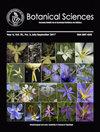The vascular plant species endemic or nearly endemic to Puebla, Mexico
IF 0.7
4区 生物学
Q3 PLANT SCIENCES
引用次数: 0
Abstract
Background: Knowledge of endemism in a region (natural or political) is fundamental to determining natural biogeographic regions and establishing conservation priorities. Questions: How many vascular plant species are endemic to the state of Puebla? What is the geographic distribution of endemism in the state? Are there centers of phylogenetic endemism? Studied species: 356 species of vascular plants. Study site: State of Puebla, Mexico. Methods: Based on the literature review and botanical specimens in digitized databases, the vascular plant species endemic or nearly endemic to the state of Puebla, Mexico, was assessed. Using a grid cell 1° × 1° latitude and longitude size, the incidence of each species was assessed. With the above information and a phylogeny of the species, a spatial phylogenetic analysis was carried out to detect centers of phylogenetic endemism. Results: 82.6 % of the 356 endemic species to Puebla are distributed in only one to three grid cells. The spatial phylogenetic analysis revealed centers of high phylogenetic diversity and endemism as well as delineated centers of mixed and paleo-endemism. Conclusions: The state of Puebla contains areas that meet the criteria to be considered centers of species endemism. Strategies toward a better understanding of plant endemism, as here proposed, suggest a better comprehension of the chorology of Mexican endemism, and assess the true role of our natural protected areas in conserving endemic species.维管植物是墨西哥普埃布拉的特有种或几乎特有种
背景:了解一个地区(自然或政治)的地方性是确定自然生物地理区域和确定保护重点的基础。问题:有多少维管植物物种是普埃布拉州特有的?该州特有的地理分布是怎样的?有系统发育的地方性中心吗?研究种类:维管植物356种。研究地点:墨西哥普埃布拉州。方法:利用文献资料和数字化数据库中的植物标本,对墨西哥普埃布拉州特有或接近特有的维管植物种类进行评估。采用1°× 1°纬度和经度大小的网格单元,评估各物种的发病率。利用上述信息和物种的系统发育,进行空间系统发育分析,寻找系统发育特有的中心。结果:356种普埃布拉特有种中82.6%仅分布在1 ~ 3个网格细胞内。空间系统发育分析显示了高系统发育多样性和地方性中心,并划定了混合和古地方性中心。结论:普埃布拉州包含符合物种特有种中心标准的地区。本文提出了更好地了解植物特有的策略,建议更好地理解墨西哥特有的历史,并评估我们的自然保护区在保护特有物种方面的真正作用。
本文章由计算机程序翻译,如有差异,请以英文原文为准。
求助全文
约1分钟内获得全文
求助全文
来源期刊

Botanical Sciences
Agricultural and Biological Sciences-Plant Science
CiteScore
1.90
自引率
21.40%
发文量
71
审稿时长
16 weeks
期刊介绍:
Botanical Sciences welcomes contributions that present original, previously unpublished results in Botany, including disciplines such as ecology and evolution, structure and function, systematics and taxonomy, in addition to other areas related to the study of plants. Research reviews are also accepted if they summarize recent advances in a subject, discipline, area, or developmental trend of botany; these should include an analytical, critical, and interpretative approach to a specific topic. Acceptance for reviews will be evaluated first by the Review Editor. Opinion Notes and Book Reviews are also published as long as a relevant contribution in the study of Botany is explained and supported.
 求助内容:
求助内容: 应助结果提醒方式:
应助结果提醒方式:


